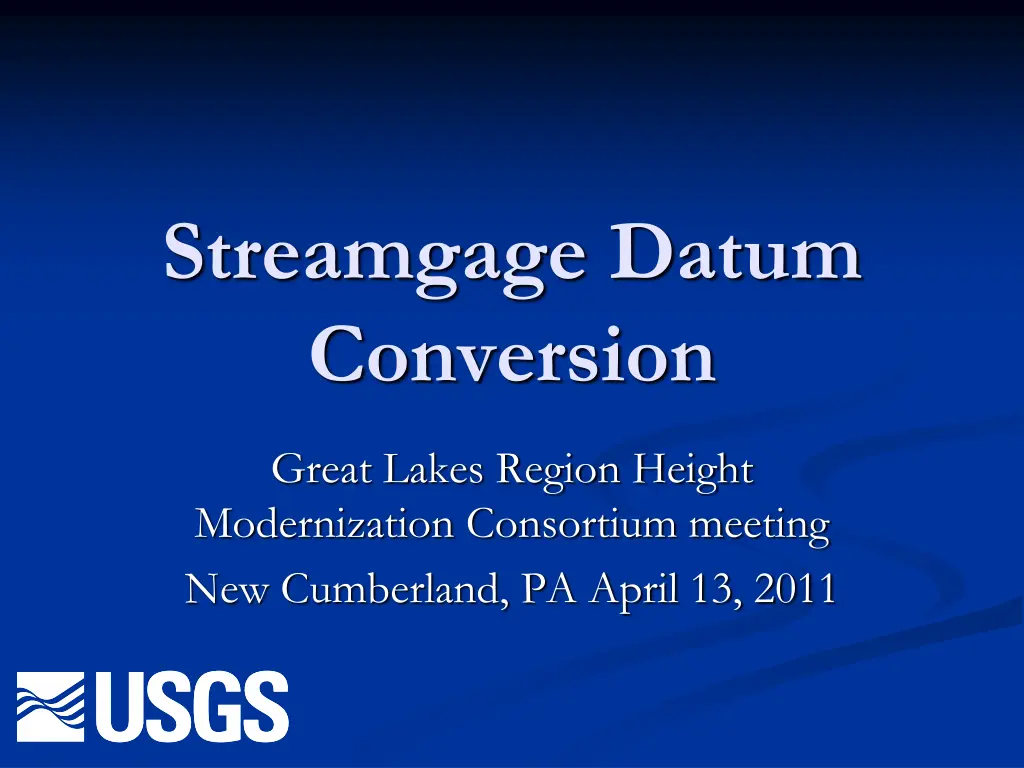
USGS Streamgage Datum Conversion and Height Modernization Consortium Meeting
Learn about the challenges faced by USGS streamgages with datum discrepancies and the benefits of modernizing height data. Explore how mixing vertical datums can confuse information users and discover the recommended policy guidance for using NAVD88. Partnership applications with NWS AHPS and FEMA for flood inundation initiatives are also discussed.
Download Presentation

Please find below an Image/Link to download the presentation.
The content on the website is provided AS IS for your information and personal use only. It may not be sold, licensed, or shared on other websites without obtaining consent from the author. If you encounter any issues during the download, it is possible that the publisher has removed the file from their server.
You are allowed to download the files provided on this website for personal or commercial use, subject to the condition that they are used lawfully. All files are the property of their respective owners.
The content on the website is provided AS IS for your information and personal use only. It may not be sold, licensed, or shared on other websites without obtaining consent from the author.
E N D
Presentation Transcript
Streamgage Datum Conversion Great Lakes Region Height Modernization Consortium meeting New Cumberland, PA April 13, 2011
Topics for Discussion Problem from USGS Water perspective Database Facts How Height Modernization might help the conversion effort?
Problem Most USGS streamgages have a datum surveyed or estimated to NGVD29. Streamgages established since 2002 and surveyed using a Global Positioning System (GPS) should have datum set to NAVD88.
Problem Mixing vertical Datums creates confusion; This mixture of Altitude Datums has created a confusing situation for streamgage information users attempting to model flood plain inundation, establish flood profiles or use other hydrologic applications. In some areas of the country, the difference between NGVD29 and NAVD88 can be over 4 feet.
Partner Applications of Information NWS AHPS
Partner Applications of Information NWS AHPS
USGS/NWS/FEMA Flood Inundation Initiatives
Policy Guidance from USGS NAVD88 is the recommended datum established in the Federal Geographic Data framework (Office of Water Information Technical memorandum 2002.01).
1000 900 800 700 600 500 NAVD of 1988 400 300 200 100 0 Alaska Arizona Arkansas California Colorado Florida Georgia Idaho Illinois Indiana Iowa Kansas Kentucky Louisiana Maryland Massachusetts Michigan Minnesota Mississippi Missouri Montana Nebraska Nevada New_Jersey New_York North_Carolina North_Dakota Ohio Oklahoma Oregon Pennsylvania Puerto_Rico South_Carolina Texas Utah Virginia Washington West_Virginia Wisconsin Wyoming >2,200 SW stations 4000 3500 3000 2500 2000 NGVD of 1929 1500 1000 500 0 Alabama Alaska Arizona Arkansas California Colorado Florida Georgia Hawaii Idaho Illinois Indiana Iowa Kansas Kentucky Louisiana Maryland Massachusetts Michigan Minnesota Mississippi Missouri Montana Nebraska Nevada New_Jersey New_Mexico New_York North_Carolina North_Dakota Ohio Oklahoma Oregon Pennsylvania Puerto_Rico South_Carolina South_Dakota Tennessee Texas Utah Virginia Washington West_Virginia Wisconsin Wyoming >48,200 SW stations SW Station Datums in the USGS NWIS
Database facts 84,944 Surface-Water sites 62,032 determined elevation from Maps 7,737 from Levels 8,023 unknown source 1,269 from a GPS 4,771 already reported to NAVD88
Database facts 84,944 Surface-Water sites 62,032 determined elevation from Maps Convert these to NAVD88 directly because within existing accuracy limitations unless a determination of need for more accuracy due to data use.
Database facts 125 sites in NGS database (NGSIDB)for NAVD88 have a gage description. Assumed to be USGS streamgages Additional sites may be present but did not show up in the search Approximately 17,000 sites need to have some analysis and conversion.
NGS assistance in GPS surveys NGS is doing updating work and GPS surveys throughout the country North Carolina and Michigan -- Will survey in at least one reference mark at active gages in work areas Working on best ways to easily provide reference mark descriptions and gage locations to contractors doing this work and best way to report back to USGS.
Priority stations USGS, NGS, USACE and NWS developing priority lists of gages for conversion Pilot study in Missouri MO has been working with Darrell Pratte, NGS Geodetic Coordinator with the Missouri DNR. Darrell has volunteered to serve in a role of oversight for field surveys and provide some personnel. Plan was developed for conversion of gages in Missouri. Includes survey plans for those stations identified as needing that level of attention.
Priority stations David Ulrey of USACE is working on the same effort for their streamgages. Some gages are common to both agencies so David and Paul Rydlund (USGS) will be coordinating. (Comprehensive Elevation of Project Datum CEPD). There is generally a lot of interest when this is discussed with other agencies and organizations. People see the need even if they don t have the resources.
Priority stations USGS, USACE, NOS and NWS developing priority lists of gages for conversion Pilot study in Coastal Texas TCOON (Texas Coastal Ocean Observation Network) and Texas A&M--Corpus Christi Seeking funding to upgrade USGS sites to meet NOS tidal gage standards, both NAVD88 and local tidal datum. Next beta areas are the North Atlantic coast and the Great Lakes
Funding Sources Unfunded mandate to USGS Water Science Centers Some will need GPS surveys to meet required accuracies or because of instability issues. Can the Great Lakes Height Mod partner with the USGS efforts?
Issues to be resolved Accuracy of the conversion. Resources Time and manpower Money Data already converted to elevation in database Florida efforts
